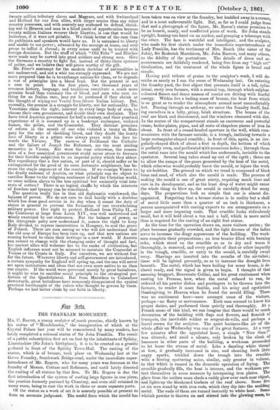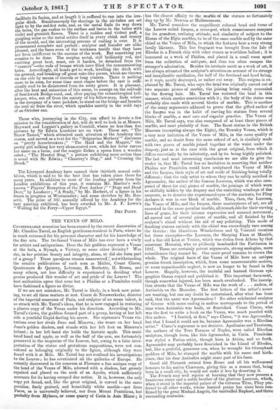fiat Ado.
FRANKLIN MONUMENT.
Mu. C. Blow, a young sculptor ofamuch promise, chiefly known by his statue of "Mendelssohn," the inauguration of which at the Crystal Palace last year will be remembered by many readers, has lately completed a colossal statue of Sir John Franklin. The result of a public subscription first set on foot by the inhabitants of Spilsby, Lincolnshire (Sir John's birthplace), it is to be erected on a granite pedestal in front of the Spilsby Town-Hall. The casting of the statue, which is of bronze, took place on Wednesday last at the Grove Foundry, Southwark Bridge-road, under the immediate super- intendence of Mr. Rogers, who for many years was foreman at the foundry of Messrs. Cottam and Robinson, and until lately directed the casting of all statues by that firm. To Mr. Rogers is due the first introduction of the system of casting large figures in one piece, the practice formerly pursued by Chantrey, and even still retained in many cases, being to cast the work in three or more separate parts.
Of the statue as a work of art it is scarcely possible at present to form an accurate judgment. The model from which the mould has
been taken was on view at the foundry, but huddled away in scorner, and in a most unfavourable light. But, as far as I could judge from that and a photograph of the figure, Mr..Bacon's statue promises to be an honest, manly, and unaffected piece of work. Sir John stands upright, leaning one hand on an anchor, and grasping a telescope with the other. The face is watchful and intelligent, and the sculptor, who made his first sketch under the immediate superintendence of Lady Franklin, has the testimony of Mrs. Booth (the sister of Sir John), Sir Roderick Murchison, Mr. John Barrow, and many others, to the fidelity of the portraiture. The details of dress and ac- coutrements are faithfully rendered, being free from any "high art" idealization, and the treatment of the whole figure is broad and simple.
Having paid tribute of praise to the sculptor's work, I will de. scribe as nearly as I can the scene of Wednesday last. On entering the foundry-yard, the first object that presents itself is a tall, cylin- drical, rusty iron furnace, with a conical top, through which sulphur- coloured flames and dense masses of smoke are driving with fearful energy. Within lies a boiling mass of bronze, the heat from which is so great as to render the atmosphere around most uncomfortably hot. Passing through an archway, we enter the foundry itself, find- ing ourselves in a lofty, grimy, brick structure. The beams of the roof are black and discoloured, and the windows obscured with dirt. In the centre of the compartment stands an enormous and powerful crane, boiler-plates, pipes, and all sorts of shapeless pieces of iron lie about. In front of a round-headed aperture in the wall, which com- municates with the furnace outside, is a trough, inclining towards a large rectangular-shaped cracible ; in front of this, again, is an irre- gularly-shaped ditch of about a foot in depth, the bottom of which is perfectly even, and perforated with numerous holes ; through these the metal runs into the mould which lies underneath, invisible to the spectator. Several long tubes stand up out of the earth ; these are to allow the escape of the gases generated by the heat of the metal, which otherwise would probably burst the mould, or injure the work by air-bubbles. The ground on which we tread. is composed of black loam and sand, of which also the mould is made. The process of making the mould is one of great nicety, requiring much time and care in its development, and as the least drop of water might cause the whole thing to blow up, the mould is carefully dried for many days. The preparations look so simple that one is almost dis- appointed. Forgetting that a bronze statue is in reality but a shell of metal little more than a quarter of an inch in thickness, a person unacquainted with casting expects to see arrangements on a larger and more imposing scale. That crucible looks ridiculously small, but it will hold about a ton and a half, which is more metal than is required for the casting of an eight feet statue.
As the time for the operation draws on, more visitors arrive ; the place becomes gradually crowded, and the light dresses of the ladies serve to increase the dingy appearance of the building. The work- men complete their preparations ; an iron brazier filled with burning coke, which stood on the crucible so as to dry and warm it thoroughly, is removed, and every particle of dust or other impurity in the trough, crucible, or entry to the mould, is carefully swept away. Shavings are inserted into the mouths of the air-tubes; these will be lighted presently, so as to increase the draught from beneath. The metal, which has been boiling for some hours, is de- clared ready, and the signal is given to begin. I thought of that amusing braggart, Benvenuto Cellini, and his great excitement when casting his Perseus, how, when the metal refused to run, he ordered all his pewter dishes and porringers to be thrown into the furnace, to render it more fusible, and his noisy and egotistical thanksgiving to Heaven when he found the mould filling. There was no excitement here—save amongst some of the visitors, perhaps—no flurry or nervousness. Each man seemed to know his proper duties, and performed them quietly and thoroughly. At a French scene of this kind, we can imagine that there would be much decoration of the building with flags and flowers, and flourish of trumpets, the inevitable soldier or sergent-de-ville, and perhaps a laurel crown for the sculptor. The quiet business-like air of the whole affair on Wednesday was one of its great features. At a very few minutes after the appointed hour, a simple "Now then!" was uttered; and amid a silence, only broken by the clank of hammers in other parts of the building, a workman proceeded to let loose the stream of metal. Like a dazzling white thread at first,- it gradually increased in size, and shooting forth little angry sparks, trickled down the trough into the crucible with a hissing spattering noise, similar, only greater in volume, to that •whicCis caused in the domestic operation of frying. The crucible gradually fills, the heat is intense, and the workmen pro- tect themselves in some measure by interposing iron plates. The glare from the molten mass sheds a ruddy glow over each near object, and lights up the blackened timbers of the roof above. Some five or six men stand by with iron rods, which they dip into the scalding metal. The ends of them are turned instantly to white heat. Some whitish powder is thrown on and stirred into the glowing mass, to facilitate its fusion, and at length it is suffered to run into the irre- gular ditch. Simultaneously the shavings in the air-tubes are set light to by the red-hot rods, and, as the metal finds its way down the holes, the gas rushes to the suiface and burns in the tubes with violet and greenish flames. There is a sudden and violent puff, a gurgling noise as the metal settles itself in every chink and cranny of the mould, and the interesting process of casting is over. It is pronounced complete and perfect sculptor and founder are alike pleased, and the faces even of the workmen testify that they have not been indifferent to the success of the work. But something yet remains to be done. The surplus metal, still brilliantly red, and emitting great heat, mast, ere it harden, be detached from the "runners"—the rods of bronze which have filled the communicating holes. Accordingly, all hands get to work, levelling the ditch with the ground, and breaking off great cake-like pieces, which are thrown on one side by means of shovels or long pincers. There is nothing more to be seen, for some time must elapse before the cast is suffi- ciently cool to be disinterred from its sooty grave. It is pleasant, after the heat and animation of this scene, to emerge on the solitude of Southwark Bridge-road, and, after paying the misanthropical toll- keeper, who, cut off from the society of his fellow-man, finds solace in the company of a tame jackdaw, to stand on the bridge and breathe the cool air from the river, which sparkles merrily in the mild rays of an October sun.
Those who, journeying in the City, can afford to devote a few minutes to the consideration of Art, will do well to look in at Messrs. Hayward and Leggett's gallery in Cornhill, where no less than five pictures by Sir Edwin Landseer are on view. These are, " The Shrew Tamed," which attracted such attention at the Academy this season, and served as a text for the "Belgravian Mothers" discourse on "pretty horsebreakers ;" "The Maid and the Magpie," the pretty girl milking her very clean-coated cow, while her lover carves her name on a beam, and the magpie filches a spoon from a wooden sabot ; "The Hunted Stag," a picture exhibiting more action than is usual with Sir Edwin; " Chantrey's Dog ;" and "Crossing the Brook."
The Liverpool Academy have opened their thirtieth annual exhi- bition, which is said to be the best. that has taken place there for many years. In addition to most of the leading pictures from the London exhibitions of this year, it contains Mr. Maclise's well- known " Players' Reception of the Poor Author ;" "Dogs and Dead Deer," by Landseer; "A Study," by Mr. Herbert, of a figure in his fresco in progress at Westminster; and some sketches by Mr. Ros- setti. The prize of 501. annually offered by the Academy for the best painting exhibited, has been awarded to Mr. J. F. Lewis's " Waiting for the Ferry—Upper Egypt."
DRY POINT.































 Previous page
Previous page